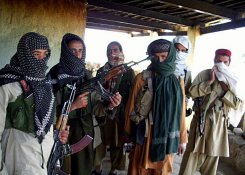An American charged with helping plan the 2008 terrorist attacks in Mumbai, India, moved effortlessly between the United States, Pakistan and India for nearly seven years, training at a militant camp in Pakistan on five occasions, according to a plea agreement released by the Justice Department last week.

The odyssey of David C. Headley, 49, included scouting targets in several cities in India and meeting with a senior operative of Al Qaeda in Pakistan’s tribal areas. These and other new details of Mr. Headley’s activities, contained in the plea agreement, raise troubling questions about how an American citizen could travel for so long undetected from his home base in Chicago to well-established terrorist training camps in Pakistan.
The document shows that Mr. Headley made two trips to North Waziristan, the heart of Qaeda operations in the tribal area where the United States is still pushing Pakistan for a military offensive to clear out militants. His handlers, the document reveals, included a former Pakistani military commander with ties to a Pakistani extremist group and even Al Qaeda.
From there, Mr. Headley not only helped plan the Mumbai attack, it says, but he was put in contact with a Qaeda cell in Europe that may still be operative. The document shows the cell was well supplied with weapons and money and primed for an attack until the moment Mr. Headley was arrested by the F.B.I. at O’Hare airport last October.
Mr. Headley divulged details of his life as a spy and militant as part of a plea agreement that will spare him the death penalty, his lawyer, John T. Theis, said this week. Mr. Headley’s maximum sentence would be life imprisonment, he said. As part of his plea, Mr. Headley has volunteered to talk to the authorities in India, Pakistan and Denmark, where he was plotting with a Qaeda cell to attack the Copenhagen offices of the newspaper that had printed derisive cartoons of the Prophet Muhammad, the agreement says.
The revelations around the European cell were particularly disturbing, said Bruce Riedel, who was a member of the National Security Council in the Clinton administration and is now at the Brookings Institution. They showed that “Al Qaeda still has a significant operational infrastructure somewhere in Europe,” he said. Mr. Headley’s story also showed in clear contours the close relationship between Al Qaeda and the Pakistani militant group Lashkar-e-Taiba, he said.
Mr. Headley was able to use his Pakistani and American heritage to great advantage, playing up his American descent on his mother’s side in India, and then behaving as a Pakistani in Pakistan, where his father was born.
As he became more intensely involved in the web of militant activities in Pakistan — sometimes training for months at a time — and then making five trips to Mumbai from 2006 to 2008 to scout locations, Mr. Headley kept his base in Chicago, the document says.
Mr. Headley started his career as a militant scout with Lashkar-e-Taiba, a terrorist group established decades ago with the help of the Pakistani military and intelligence agencies to fight against India’s control of disputed territory in Kashmir.
Lashkar was supposed to have been outlawed in Pakistan in 2002, but it remains active behind the veil of a public charity in Pakistan and, according to Mr. Headley’s plea, continued to be assisted by former Pakistani military officials in recent years.
From 2002 to 2005, Mr. Headley trained at Lashkar camps on five occasions, learning about explosives, small arms and countersurveillance techniques.
The plea names a retired Pakistani military officer, Col. Abdur Rehman Hashim Syed, known as Pasha, as Mr. Headley’s main contact with Lashkar. Earlier prosecution documents said that Colonel Syed was arrested last year in Pakistan on unspecified charges, but then released. In early 2009 Colonel Syed introduced Mr. Headley to Muhammad Ilyas Kashmiri, a Qaeda operative in North Waziristan, according to the document.
Colonel Syed then served as the go-between for the men, who all met together in North Waziristan, according to the document.
The visit in February 2009 may finally have put Mr. Headley on the radar of the American authorities, who started tracking him in the late spring of last year, Mr. Riedel said. Mr. Kashmiri is considered to be one of Al Qaeda’s most dangerous commanders. The Long War Journal, a Web site that specializes in reports on militancy, says he is a former member of Pakistan’s elite commando Special Services Group, though Pakistani intelligence officials deny that. He was the target of a drone attack last September. After initial reports that he was killed, it appears that he survived, according to Pakistani officials and militants.
It was Mr. Kashmiri who asked Mr. Headley to help plan the attack against the Danish newspaper, the plea document says.
After Mr. Headley’s second trip to North Waziristan in May of last year, he was told by Mr. Kashmiri that the “elders” had approved the attack in Denmark, a remark that Mr. Headley understood to mean the Qaeda leadership, the agreement says.
The attack against the newspaper, which involved a Qaeda cell already in place in Europe, was planned to be particularly gruesome, with suicide attackers trying to kill everyone in the building, the plea says.
As the planning for the Copenhagen attack unfolded, Mr. Headley returned to Denmark for a final scouting mission last August.
He then met with the Qaeda team in Europe, according to the agreement. The precise location of that meeting with Qaeda operatives is not specified in the document, apparently in deference to investigations by Western intelligence agencies. When Mr. Headley was arrested on Oct. 3, 2009, he was headed to Pakistan once again to meet Mr. Kashmiri in North Waziristan to hand over 13 surveillance videos he had taken in Copenhagen.
Mr. Headley’s plea agreement with the government was not his first. After being sentenced for drug trafficking in the 1990s, he served as an informant in Pakistan for the Drug Enforcement Agency as part of a deal for a lighter sentence. He was in Pakistan for the drug agency from the late 1990s until at least 2001. By 2002, he was training with Lashkar, raising the possibility that he had made contact with the militants while still working for the drug agency.
In addition to sites in Mumbai, Mr. Headley scouted targets in Pune and Goa, the document says. He was sent to Mumbai several times, it says. There, he made videos of the targets, including the Taj Mahal Hotel, took coordinates with a GPS unit, and scouted sites in the harbor where 10 Lashkar militants landed Nov. 26, 2008, in inflatable boats. They killed 163 people.
